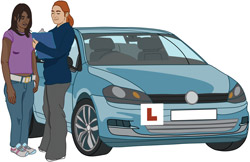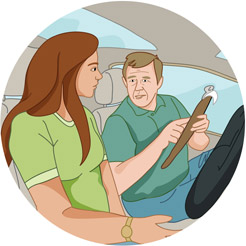Professional Lessons

Professional lessons with an Approved Driving Instructor (ADI) are an essential part of learning to drive.
It is important that learner drivers take frequent, and regular professional lessons during their learning period. The lessons should be spread over a period of weeks and months, rather than crammed into a short intensive course.
The ideal number of lessons will vary for each learner, but there should be at least 50 hours of professional instruction.
Driving Lessons on Motorways
From Monday 4 June 2018, learner car drivers are able to take driving lessons on motorways with an approved driving instructor. This is designed to help learners to get training on how to join and leave motorways, overtake and use lanes correctly, practise driving at higher speeds, understand motorway traffic signs and improve their confidence of driving on the motorway. It will help to prepare them for the type of driving they will do after passing their driving test.
Parents or other qualified drivers who supervise learner drivers during private practice, cannot take learners onto a motorway. To take motorway driving lessons, learner drivers must be accompanied by a professional driving instructor (an approved driving instructor, ADI) and be driving a car fitted with dual controls that is displaying L plates or has a driving school rooftop box.
It will be up to the driving instructor to decide when the learner driver is ready to take motorway lessons.
Make sure both the instructor (ADI) and the learner are prepared for motorway driving, which is different from driving on other types of road. Ask your driving instructor whether they use the National Associations Strategic Partnership’s ‘Motorway tuition guidelines’.
Remember, learners cannot take motorway lessons before 4 June 2018 and learner motorcyclists will not be allowed on motorways even after 4 June 2018. Trainee driving instructors will not be allowed to take learner drivers on the motorway.
Motorways lessons will not be compulsory and motorway driving will not be included in the driving test.
Further details are available at https://www.gov.uk/government/news/learner-drivers-will-be-allowed-on-motorways-from-2018
What is an ADI?
ADI stands for Approved Driving Instructor, which is the proper name for professional driving instructors. All ADI's must reach certain high standards of instruction which are set and monitored by the Driver and Vehicle Standards Agency (DVSA). Only ADIs, or trainee ADIs, can charge for driving lessons. It is illegal for anyone else to charge or receive money to teach someone to learn to drive.
Approved Driving Instructors will display a green ADI certificate in the windshield of the vehicle during lessons. Some will have a pink certificate which indicates that they are a trainee instructor, and are getting teaching experience before they pass their instructors exam.

Choosing an ADI
Use 'Find your nearest driving instructors' at www.gov.uk/find-driving-schools-and-lessons#before-you-start), or local directories or word of mouth recommendations. Look for one who offers refresher courses and who has signed up to the DVSA's voluntary continuing professional development (CPD) scheme and the ADI code of practice.
It is worth speaking to other parents whose children have learnt to drive, and to the learners themselves. They may be able to recommend a good instructor.
The Driver and Vehicle Standards Agency (DVSA) checks ADIs (at least once every four years) to assess their ability to help their pupils become safe drivers. From 7 April 2014, ADIs are marked on three main areas:
- Lesson planning
- Risk management
- Teaching and learning skills
They will be given one of the following grades after their standards check:
- A grade (85% or over) - an overall high standard of instruction
- B grade (60% or over) - a sufficient level of competence
- Fail (less than 60%) - an unsatisfactory performance
We recommend choosing an instructor who has an A grade if possible.
Before 7 April 2014, ADIs were assessed in a different way, and give a grade from 0 to 6. They will still use these grades until they have been re-assessed under the new system. For these ADIs, we recommend choosing one with a grade 5 or grade 6.
Also take the instructor's car into account and make sure that it is suitable for your learner - that he or she can adjust the seat and head restraint to give them good visibility and protection. It's also useful if the instructor's car is similar in size and power to the one used for private practice. It should certainly have the same type of gears - manual or automatic.
If the learner passes their test in an automatic car, they will only be licensed to drive an automatic car. To gain a licence to drive a car with manual gears, they would have to take (and pay for) the test again in a manual car.
Ask the instructor if he or she will allow you to sit in the rear of the car during some lessons. This can be very useful, especially if you are supervising your learner during private practice between the lessons. It will help you to understand what the ADI is covering, why and when they are covering specific topics and help to ensure that what you cover during private practice complements the professional lessons.
Regular Communication with Your Learner's Instructor
It is very important to maintain good communication with your learner's instructor. First of all, to check when it is safe to begin private practice, and then to co-ordinate what happens during practice drives with the professional lessons. This will ensure that the learner gains the maximum benefit from their learning experience, and the best value for money for the lessons.
The instructor will tell the learner driver what skills he or she needs to brush up on after each lesson, and you should concentrate on these skills. Although the learner will probably have some idea of the parts of their driving they need to improve, encourage them to ask the instructor at the end of every lesson what they should practice before the next lesson.
If you have any concerns about the driving techniques being taught by the instructor, discuss these with him or her rather than contradict them during practice drives.
Ask to sit in on some of the lessons; most instructors should be happy for you to do this. It will help you pick up how professional lessons are structured and how the driving instructor helps and encourages the learner to develop their skills as a safer driver. It will also give you a good idea of the routes being used and traffic situations they encounter on them.
If possible, show the learner's instructor the 'Driver's Record' or the telematics data frequently so they can see how the learner is doing in their practice drives.
